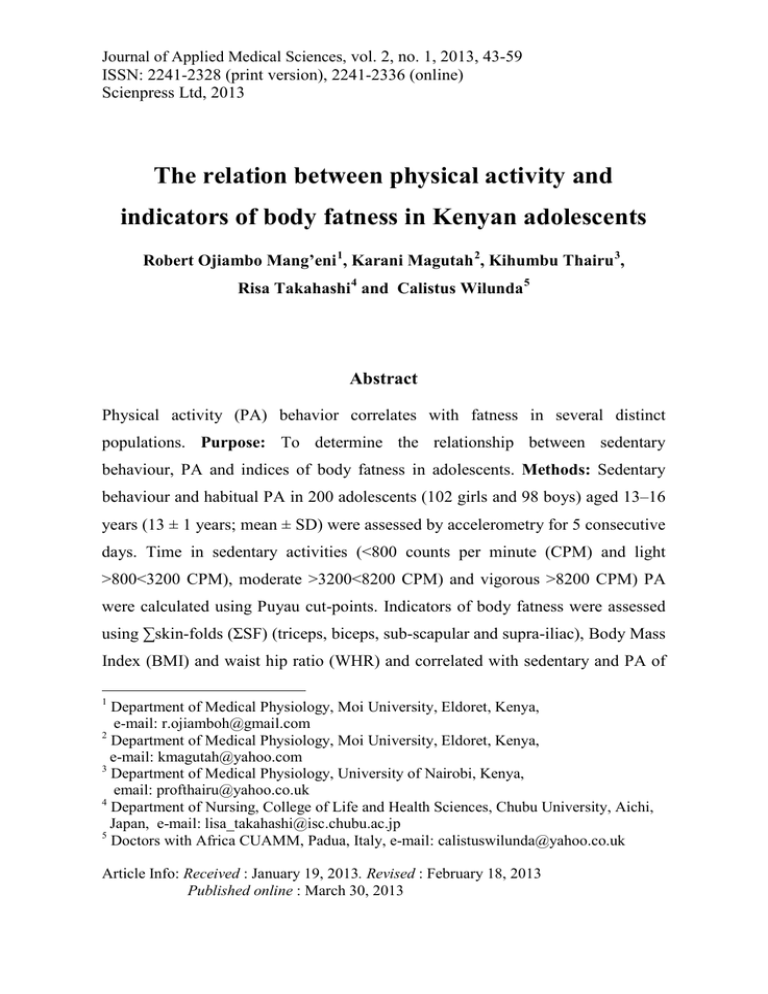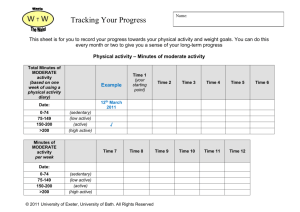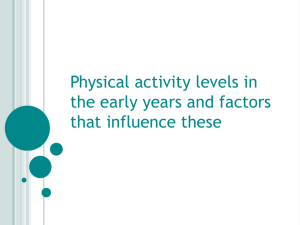The relation between physical activity and Abstract
advertisement

Journal of Applied Medical Sciences, vol. 2, no. 1, 2013, 43-59 ISSN: 2241-2328 (print version), 2241-2336 (online) Scienpress Ltd, 2013 The relation between physical activity and indicators of body fatness in Kenyan adolescents Robert Ojiambo Mang’eni 1, Karani Magutah 2, Kihumbu Thairu 3, Risa Takahashi 4 and Calistus Wilunda 5 Abstract Physical activity (PA) behavior correlates with fatness in several distinct populations. Purpose: To determine the relationship between sedentary behaviour, PA and indices of body fatness in adolescents. Methods: Sedentary behaviour and habitual PA in 200 adolescents (102 girls and 98 boys) aged 13–16 years (13 ± 1 years; mean ± SD) were assessed by accelerometry for 5 consecutive days. Time in sedentary activities (<800 counts per minute (CPM) and light >800<3200 CPM), moderate >3200<8200 CPM) and vigorous >8200 CPM) PA were calculated using Puyau cut-points. Indicators of body fatness were assessed using ∑skin-folds (ΣSF) (triceps, biceps, sub-scapular and supra-iliac), Body Mass Index (BMI) and waist hip ratio (WHR) and correlated with sedentary and PA of 1 Department of Medical Physiology, Moi University, Eldoret, Kenya, e-mail: r.ojiamboh@gmail.com 2 Department of Medical Physiology, Moi University, Eldoret, Kenya, e-mail: kmagutah@yahoo.com 3 Department of Medical Physiology, University of Nairobi, Kenya, email: profthairu@yahoo.co.uk 4 Department of Nursing, College of Life and Health Sciences, Chubu University, Aichi, Japan, e-mail: lisa_takahashi@isc.chubu.ac.jp 5 Doctors with Africa CUAMM, Padua, Italy, e-mail: calistuswilunda@yahoo.co.uk Article Info: Received : January 19, 2013. Revised : February 18, 2013 Published online : March 30, 2013 44 Physical activity and indicators of body fatness in Kenyan adolescents different intensities. Results: Time in sedentary activity was positively correlated with BMI (r =0.44, P<0.001) and ΣSF (r = 0.21, P = 0.003). CPM and time spent engaged in light, moderate and vigorous intensity activities were negatively correlated with BMI and ΣSF. 16.1% of variation in ΣSF could be explained by gender; R2 = 11.4% and time spent engaged in sedentary activities, R2 = 4.7%; P<0.05. Conclusion: Time engaged in sedentary activity and PA was a significant predictor of indices of adiposity in adolescents. Keywords: Accelerometry, skinfold thickness, physical activity, adolescents 1 Introduction The association between a physically active lifestyle and the prevention of many chronic diseases is well documented [1, 2]. Physical activity has beneficial effects on adiposity, musculoskeletal health, fitness and cardiovascular health [3]. In adults, physically active individuals appear to have a lower risk of various diseases and health conditions such as cardiovascular disease (CVD), hypertension, type 2 diabetes, and obesity when compared to sedentary individuals [2]. Furthermore, evidence of the health implications associated with the lack of PA among children is constantly growing [1] and is thought to be associated with childhood obesity [4-6]. Obese children and adolescents experience significant short and long-term health problems such as CVD, hyperlipidaemia, hypertension, glucose intolerance, type 2 diabetes, psychiatric disorders and orthopedic complications [5,7] and have an increased risk of developing adult obesity [2, 8]. The prevalence of obesity and related co-morbidities among children and adolescents is increasing rapidly [9]. Childhood obesity is a reality and is already showing signs in Africa as a result of nutrition and PA transition. Consequently, there is need for Africa to be Robert Ojiambo Mang’eni, et al 45 proactive so as to prevent this pandemic [9]. Accordingly, current interventions are focused on enhancement of PA in children and youth to modify the risk of obesity [7]. This is especially so, since it has been demonstrated that PA, objectively assessed by accelerometers, is related to body fat content, in several populations [10-12]. Experts advocate promotion of PA among children and adolescents for health enhancement and to instil lifelong behavioural patterns that will result in a more active and fit adult population in the future [13] based on the assumption that childhood PA tracks into adulthood. Indeed, it has been shown that physical inactivity in children tracks into adolescence [14] and from adolescence into adulthood [15]. Therefore the current emphasis is on enhancement of childhood habitual PA levels to not only prevent clustering of cardiovascular risk factors but also to modify disease risk later in life. The overall challenge in the battle against the rising levels of obesity is to better understand the modifiable determinants of PA and to translate this knowledge into practical actions for a general public health benefit as well as for the individual to keep a healthy body weight [16]. The purpose of this study therefore, was to objectively determine the relation between objectively assessed sedentary behaviour; habitual PA levels and patterns and indicators of adiposity in Kenyan adolescents. 2 Material and Methods 200 adolescents (102 girls and 98 boys) aged 13–16 years (13 ± 1 years; mean ± SD) (Table 1) were recruited to participate in this study. All females verbally reported that they were post-menarche. Informed written consent was obtained from the subjects’ parents and Principals in the participating schools in Eldoret Municipal Council. Ethical approval was granted by the Institutional Research and Ethics Committee (IREC), Moi University, Eldoret, Kenya. 46 Physical activity and indicators of body fatness in Kenyan adolescents Habitual PA levels were assessed by uniaxial accelerometry for 5 consecutive days. The ActitrainerTM (ActiGraph, Fort Walton Beach, Florida, USA) is a novel single axis accelerometer designed to measure and record time varying accelerations ranging in magnitude from approximately 0.05 to 2 Gs. The Actitrainer TM is surrounded in a metal shield and packaged into a plastic enclosure measuring 5 x 4 x 1.5 cm, weighs approximately 45 g including a 3V (2430) coin cell lithium battery, and has a sampling range of 0.25 to 2.5 Hz. Further, it has a sampling frequency of 30 Hz and contains a cantilevered rectangular piezoelectric bimorph plate and seismic mass, a charge amplifier, analog band-pass filters, and a voltage regulator to measure acceleration in a single plane. The filtered acceleration signal is digitalised and the magnitude is summed over a user specific time (an epoch interval). At the end of each epoch the summed value is stored in memory and the numerical integrator reset. Physical activity levels were calculated using cut-points for sedentary, light, moderate and vigorous PA developed by Puyau et al [17]. The study was conducted for 5 consecutive days in January 2010. Before each test period and for each subject, the activity monitors were tested and fully charged. The accelerometer was placed in a small nylon pouch and firmly adjusted at the right hip of the subject by an elastic belt. The epoch duration was set to 1 s and re-integrated to 60 s using the device software. This epoch interval has been validated against criterion methods in children and adolescents [17]. Data were then further edited automatically to delete periods of 20 min or longer of consecutive zero counts prior to further analysis as recommended by Treuth [18] who previously found that a period of 20 min or more of consecutive zero counts was not consistent with the awake state in children and adolescents. Due to poor subject compliance in accelerometer wear, a minimum of 6 hours of monitoring per day, for at-least 3 days, was considered valid for evaluation of habitual PA levels. This monitoring period has been shown in previous studies to be sufficient in quantify habitual PA in children [19, 20]. The cut-points used in the present Robert Ojiambo Mang’eni, et al 47 study have been validated in children and adolescents aged 6-16 years, these were: sedentary activities (<800 counts per minute (CPM) and light >800<3200 CPM), moderate >3200<8200 CPM) and vigorous >8200 CPM) [17]. Height was measured to the nearest 0.1 cm using a portable stadiometer (Somatometre Model SE V91, Seca, Birmingham, UK) and weight measured to the nearest 0.1 kg using portable scales (Seca, Model 761, Vogel & Halke, Hamburg, Germany) for all children and used to calculate BMI. BMI relative to International Obesity Task Force (IOTF) [21] definitions was used to define subjects as overweight or obese. Fat mass was estimated using skin-fold calipers (Harpenden, Holtain, Wales UK) at four-skin fold sites, biceps, triceps, sub-scapular, and supra-iliac by pinching the skin at the appropriate site and the layer of subcutaneous fat measured with the calipers [22]. Waist and hip girths were also determined using a standard measuring tape and waist/hip ratio (WHR) computed. Descriptive statistics included calculations of means, standard deviation or median (range) following Shapiro-Wilk test for normality. Time spent in sedentary activities was normally distributed. On the other hand, Time spent in light, moderate and vigorous intensity activities was not normally distributed therefore the non-parametric Mann-Whitney U-test for two independent samples was used to determine differences between the sexes. Independent t-tests were used to determine differences between sexes in mean sedentary time. Pearson correlation coefficient was used to test the relationship between engagement in sedentary and physical activities and Body Mass Index (BMI) and ∑ skin-folds (∑SF). Multiple regression analysis was also conducted to assess the relation between engagement in sedentary and physical activities of different intensities and BMI and ∑SF with significance declared at P<0.05. All statistical analysis was completed using the software package SPSS, Version 15.0 (SPSS, inc., Chicago, IL). 48 Physical activity and indicators of body fatness in Kenyan adolescents 3 Main results Descriptive statistics of the subjects are presented in Table 1. Subjects wore the accelerometers for an average of 13 ± 2 hours, with an average CPM of 753 ± 235 (Table 1). Daily mean sedentary time was 619 ± 109 min. Thus, subjects spent approximately 78% of their monitored time in sedentary activities. On the other hand, Kenyan adolescents spent 127 ± 44 min daily engaged in light activities; which was approximately 16% of the monitored time (Table 1). Furthermore, subjects spent 53 ± 22 min in moderate intensity activity; this was approximately 7% of the monitored time. In addition, subjects spent 0.7 (0-13) min of the monitored time in vigorous intensity activity, this was approximately 0% of the monitored time (Table 1). Total habitual PA assessed as average CPM was not significantly different in female vs. male subjects (740 ± 234 vs. 767 ± 236 CPM, respectively; P>0.05) (Table 1). Similarly, there were no significant differences in male vs. female subjects in time spent engaged in sedentary, light and vigorous intensity activities (P>0.05) (Table 1). In contrast, time spent engaged in moderate intensity activities was significantly different between female and male subjects (P<0.05) (Table 1). Mean BMI was significantly higher in female vs. males subjects (18.1 ± 2.9 vs. 17.3 ± 3.3 kg.m-2, respectively, P<0.001) (Table 1). Similarly mean WHR was significantly higher in female vs. male subjects (0.81 ± 0.1 vs. 0.84 ± 0.1, respectively, P<0.05). Moreover, female subjects had a significantly higher ΣSF compared to male subjects (36.5 ± 16 vs. 23.4 ± 20.5, respectively, P<0.05) (Table 1). Furthermore, in the present study; 1 male subject was classified as obese where as 4 male and 5 female subjects were classified as overweight according to IOTF definitions (Cole et al., 2000). Therefore, the prevalence of overweight/obesity in our cohorts was estimated as 5% (i.e. 10 out of 200). Time spent engaged in sedentary activity was positively correlated with BMI (r =0.44, P<0.001) and ΣSF (r = 0.21, P = 0.003) (Table 2). In addition, total volume of physical activity (CPM) and time spent engaged in light, moderate and Robert Ojiambo Mang’eni, et al 49 vigorous intensity activities were negatively correlated with BMI and ΣSF (Table 2). In order to explore other factors that may be associated with BMI and ΣSF and objectively measured PA and sedentary behaviour in the present study, total volume of PA (as evaluated by average CPM) and intensities of PA and sedentary behaviour were assessed by multivariate stepwise regression analysis. The regression model included sedentary time, CPM, PA of different intensities, gender and age. 33.8% of the variation in BMI could be explained by time spent engaged in light intensity activities; R2 = 27.3% and CPM, R2 = 6.5%; P<0.05. In addition, 16.1% of the variation in ΣSF could be explained by gender; R2 = 11.4% and time spent engaged in sedentary activities, R2 = 4.7%; P<0.05. 50 Physical activity and indicators of body fatness in Kenyan adolescents 4 Labels of Tables Table 1: Descriptive characteristics of Kenyan adolescents (n = 200) All Subjects Age (years) Height (m) Weight (kg) BMI (kg·m-2) WHR Triceps (mm) Biceps (mm) Sub-scapular (mm) Supra-iliac (mm) ∑SF Sedentary (min) Light (min) Moderate Vigorous (min) CPM mean±SD) 200 13.1±0.8 1.6±0.1 45.4±8.5 17.7±7.3 0.8±0.1 9.8±5.6 5.1±4 7.3±5.3 7.8±5.8 30±19.5 619±109 127±44 53±22 0.7±1 753±235 [Range] [13.0-16.0] [1.3-1.9] [25-84] [9.3-35.4] [0.7-1.1] [3.2-48] 2.2-51] [2-63] [1.8-50] [10.8-212] [307-921] [44-243] [14-123] [0-13] [310-1342] ‡ Significant difference between males and females Female (mean±SD) 101 13.0±0.7 1.6±0.1 46.1±7.9 18.1±2.9 0.8±0.1 12±5.4 5.8±2.6 8.8±4.1 10±5.5 36.5±16 617±116 121±41 49±23 1±1 740±234 [Range] [13.0-14.0] [1.4-1.8] [25.0-63.0] [9.3-24.5] [0.7-0.9] [3.2-28.2] [2.2-15] [2.0-23.4] [2-27] [10.8-83.6] [307-855] [53-237] [14-104] [0-8] 310-1342] Male (mean±SD) 99 13.2±0.9 1.6±0.1 44.7±9.1 17.3±3.3‡ 0.8±0.1‡ 7.6-5.1‡ 4.4±5.1‡ 5.8±6‡ 5.6±5.2‡ 23.4±20.5‡ 620±103 132±45 58±21‡ 1±2 767±236 [Range] [13.0-16.0] [1.3-1.9] [27.6-84] [10-35.4] [0.7-1.1] [3.4-48] [2.2-51] [2.6-63] [1.8-50] [11.4-212] [423-921] [44-243] [19-123] [0-13] [313-1324] Robert Ojiambo Mang’eni, et al 51 Table 2: Pearson correlation coefficients between BMI, ∑SF and time (min) engaged in sedentary and PA of different intensities Activity Sedentary Light BMI r = 0.44, P<0.001† r =- 0.52, P<0.001† r = -0.37, P<0.001† r =-0.24, P=0.03† ∑SF r = 0.21, P =0.003† r = -0.21, P = 0.02† mean±SD † - Significantly correlated (P<0.05) BMI – Body mass index ∑SF – Sum of skinfold thickness CPM – Accelerometer counts per minute Moderate Vigorous CPM r = -0.5, P<0.001† r = -0.26, P<0.001† r = -0.15, P<0.001† r = 0.16, P =0.002† 52 Physical activity and indicators of body fatness in Kenyan adolescents 5 Discussion The prevalence of overweight/obesity in our cohort was 5% which is lower than the global prevalence rates [21]. This finding confirms that over-nutrition may be less of a problem than under-nutrition and stunting in our cohort. A previous study indicates stunting in growth is a common feature of most developing countries whose economy is based on human labour [23]. Furthermore, recent evidence indicates stunting in children is accompanied by fat deposition especially in the abdominal region which may predispose them to obesity in adulthood [24]. Therefore, it should not be assumed that stunting and obesity are mutually exclusive; thus the prevalence of obesity in developing countries needs to be continuously monitored. In the present study, sedentary behaviour as well as PA of various intensities were correlated with BMI and ∑skin-folds (Table 2). Our findings on the relationship between PA and indices of adiposity are broadly consistent with similar work in the literature [23, 25]. The aetiology of the development of juvenile obesity and related comorbidities is poorly understood but likely explained by the alteration in the regulation of energy balance [26]. Obesity that begins in early childhood persists into adulthood [27]. Plausible explanation to the increasing prevalence of juvenile obesity relates to cultural changes accompanying societal development, such as decreased requirement for PA and greater abundance and availability of food [28]. Moreover, increased sedentary activities such as study and television viewing have displaced PA and consequently are associated with increased BMI in adolescents [29]. Studies on juvenile adiposity are topical since it has been previously demonstrated that accumulation of visceral fat begins early in life and is associated with non-insulin dependent diabetes mellitus and cardiovascular disease (CVD) even in childhood [30, 31]. Furthermore, skin-fold thickness was related to a high risk profile regarding CHD, hence can be used to predict CHD [32]. Robert Ojiambo Mang’eni, et al 53 The rising incidence of non communicable diseases in the developing countries is thus partially attributable to changes in population PA patterns [33]. Consequently, the WHO global strategy on diet, PA and health emphasises the health promoting effect of PA to combat increased incidence of noncommunicable diseases [34]. Quantitative aspects of PA: that is duration and frequency, may be more important in the regulation of energy balance and health [26]. The novel science of motion sensing (accelerometry) permits a more objective assessment of PA intensity, pattern and duration which allows more insight into the relationship between PA and health. Time spent engaged in sedentary and light intensity activities were significantly associated with indices of adiposity in adolescents (Table 2). Physical activity related energy expenditure is the most variable component of daily energy expenditure and plays a key role in the regulation of energy balance [35]. Therefore, PA protects from development of obesity by increasing energy expenditure and resting metabolic rate [28]. Furthermore, PA affects substrate metabolism by promoting fat utilisation, however current evidence is inconclusive on the precise role of PA and energy expenditure in the aetiology of obesity in children [28]. Other environmental factors besides PA and food intake have been explored as plausible contributors to the obesity epidemic; such as maternal characteristics and behaviour which in turn have been found to influence child food preferences and consequently the development of obesity [36]. 6 Conclusion Increasing body fatness is accompanied by profound changes in physiological function such as alteration in total blood volume and cardiac function, contributes to the development of hypertension, elevated plasma insulin level and insulin resistance, diabetes and hyperlipidaemia [37]. Therefore, it is 54 Physical activity and indicators of body fatness in Kenyan adolescents recommended that intermittent activities during prolonged sedentary time could be considered as a functional strategy for increasing EE and improving health by stimulating physiological effects generated by muscle con-traction during lowintensity activities [38]. Furthermore, vigorous intensity activity makes a small fraction of the time and therefore it remains pertinent to determine whether particular patterns of PA are beneficial to health; especially moderate intensity activities. For example, subjects with the same PA level might accumulate their PA in very different combinations of intensity, duration, frequency and type [39]. Moreover, there is also developing interest in the concept of ‘sedentariness’ [40]. It is now increasingly accepted that sedentary behaviour is not simply a lack of PA but is an independent behaviour (TV/computer use, reading, homework, etc.), which constitutes a potential risk to health irrespective of PA level [40]. Thus, it is possible for a subject to have high levels of both PA and sedentariness [39]. Acknowledgements. The authors wish to sincerely thank the subjects for their participation in this project. References [1] M. Dencker and L. Andersen, Health-related aspects of objective measured daily physical activity in children, Clin Physiol Funct Imaging, 28, (2008), 133-144. [2] R. Whitaker, J. Wright, M. Pepe, K. Seidel and W. Dietz, Predicting obesity in young adulthood from childhood and parental obesity, N Engl J Med, 337, (1997), 869-873. Robert Ojiambo Mang’eni, et al 55 [3] W.L. Haskell, Health consequences of physical activity: understanding and challenges regarding dose-response, Med Sci Exerc Sports, 26, (1994), 649660. [4] O. Ekblom, K. Oddsson and B. Ekblom, Prevalence and regional differences in overweight in 2001 and trends in BMI distribution in Swedish children from 1987 to 2001, Scan J Public Health, 32, (2004), 257-263. [5] J. Miller, A. Rosenbloom and J. Silverstein, Childhood obesity, J Clin Endocrinol Metab, 89, (2004), 4211-4218. [6] S. Trost, L. Kerr, D. Ward and R. Pate, Physical activity and determinants of physical activity in obese and non-obese children, Int J Obes Relat Metabol Disord, 25, (2001), 822-829. [7] J.J. Reilly, E. Methven and Z. McDowell, Health consequences of obesity, Arch Dis Child, 88, (2003), 748-752. [8] H. Mossberg, 40-Year follow-up of overweight children, Lancet, 26, (1989), 491-493. [9] V.O. Onywera, Childhood obesity and physical inactivity threat in Africa: strategies for a healthy future, Glob Health Promot, 17, (2010), 45. [10] U. Ekelund, J. Aman, A. Yngve, C. Renman, K. Westerterp and M. Sjostrom, Physical activity but not energy expenditure is reduced in obese adolescents: a case-control study, Am J Clin Nutr, 76, (2002), 935-941. [11] U. Ekelund, L.B Sardinha, S.A. Anderssen, M. Harro, P.W. Franks, S. Brage, A. R. Cooper, L.B. Andersen, C. Riddoch and K. Froberg, Association between objectively assessed physical activity and indicators of body fatness in 9- to 10- y-old European children: a population based study from 4 distinct regions in Europe (the European Youth Heart Study), Am J Clin Nutr, 80, (2004), 584-590. [12] A. Rowlands, R. Eston and D. Ingledew, Relationship between activity levels, aerobic fitness, and body fat in 8- to 10-yr-old children, J Appl Physiol, 86, (1999), 1428-1435. 56 Physical activity and indicators of body fatness in Kenyan adolescents [13] J. Sallis and K. Patrick, Physical activity Guidelines for Adolescents: Consensus Statement, Pediatric Exerc Sci, 6, (1994), 302-314. [14] R. Pate, M. Pratt, S. Blair, W. Haskell, C. Macera and C. Bouchard, Physical activity and public health: A recommendations from the Centres for Disease Control and Prevention and the American College of Sports Medicine, JAMA, 273, (1995), 402-407. [15] O. Raitakari, T. Taimela, S. Porkka, R. Telama, I. Valimaki, H. Akerblom and J. Viikari, Association between physical activity and risk factors for coronary heart disease: The Cardiovascular Risk in Young Finns Study, Med Sci Sports Exerc, 29, (1997), 1055-1061. [16] W.H. Saris, S.N. Blair, M.A. van Baak, S.B. Eaton, P.S. Davies, L. Di Pietro, M. Fogelholm, A. Rissanen, D. Schoeller, B. Swinburn, A. Tremblay, K.R Westerterp and H. Wyatt, How much physical activity is enough to prevent unhealthy weight gain? Outcome of the IASO 1st Stock Conference and consensus statement, Obes rev, 4, (2003), 101–114. [17] M.R. Puyau, A.L. Adolph, A.V. Firoz and N.F. Butte, Validation and calibration of physical activity monitors in children, Obes Res, 10(3), (2002), 150-157. [18] M.S. Treuth, N.E. Sherwood, N.F. Butte, B. McClanahan, E. Obarzanek, A. Zhou, C. Ayers, A. Adolph, J. Jordan, D.R. Jacobs and J. Rochon, Validity and reliability of activity measures in African-American girls for GEMS, Med Sci Sports Exerc, 35(3), (2003), 532-539. [19] J.J. Reilly, V. Penpraze, J. Hislop, G. Davies, S. Grant and J.Y. Paton, Objective measurement of physical activity and sedentary behavior: review with new data, Arch Dis Child, 93, (2008), 614-619. [20] S. Trost, R. Pate, P. Freedson, J. Sallis and W. Taylor, Using Objective physical activity measures with youth: How many days of monitoring are needed? Med Sci Sports Exerc, 2(32), (2000), 426-431. Robert Ojiambo Mang’eni, et al 57 [21] T. Cole, M. Bellizzi, F. Katherine and W. Dietz, Establishing a standard definition for child overweight and obesity worldwide: International survey, BMJ, 320, (2000), 1240-1245. [22] J. V. Durnin and J. Womersley, Body fat assessed from total body density and its estimation from skinfold thickness: measurements on 481 men and women aged from 16 to 72 years, Br J Nutr, 32, (1974), 77-97. [23] E. Bénéfice, D. Garnier and G. Ndiaye, High levels of habitual physical activity in West African adolescent girls and relationship to maturation, growth and nutritional status: Results from a 3-year prospective study, Am J Hum Bio, 13, (2001), 808-820. [24] H.S. Kruger, B.M. Margetts and H. Vorster, Evidence for relatively greater subcutaneous fat deposition in stunted girls in the North West Province, South Africa as compared with non stunted girls, Nutr, 20, (2004), 564-569. [25] R.L. Mamabolo, H. S Kruger, A. Lennox, M.A Monyeki, A. Pienar, C. Underhay and M. Czlapka-Matyasik, Habitual physical activity and body composition of black township adolescents residing in the NorthWest Province, South Africa, Pub Health Nutr, 10(10), (2007), 1047-1056. [26] M.I. Goran, and M. Sun, Total energy expenditure and physical activity in prepubertal children: Recent advances based on the application of the doubly labeled water method, Am J Clin Nutr, 68(Suppl), (1998), 944S-995S. [27] S. Abraham, C. Collins and M. Nordsieck, Relationship of child weight status to morbidity in adults, Publ Health Rep, 86, (1979), 273-284. [28] M.I. Goran, K.D. Reynolds and C.H. Lindquist, Role of physical activity in the prevention of obesity in children, Int J Obes, 23(Suppl 3), (1999), S18S33. [29] R.J. Hancox and R. Poulton, Watching television is associated with childhood obesity: but is it clinically important?, Int J Obes, 30, (2006), 171175. 58 Physical activity and indicators of body fatness in Kenyan adolescents [30] K. Fox, D. Peters, N. Armstrong, P. Sharpe and M. Bell, Abdominal fat deposition in 11-year old children, Int J Obes, 17, (1993), 11-16. [31] S. Caprio, L.D. Hyman, S. Mc Carthy, R. Lange, M. Bronson and W.V. Tamborlane, Fat distribution and cardiovascular risk factors in obese adolescent girls: Importance of the intrabdominal fat depot, Am J Clin Nutr, 64, (1996), 12-17. [32] J.W. Twisk, H.C. Kemper, W. van Mechelen, G.B. Post G.B. and F.J. van Lenthe, Body fatness: longitudinal relationship of body mass index and the sum of skinfolds with other risk factors for coronary heart disease, Int J Obes Relat Metab Dis, 22(9), (1998), 915-922. [33] N.J. Wareham. Commentary: Measuring physical activity in Sub-Saharan Africa, Int J Epid Assoc, 30, (2001), 1369-1370. [34] World Health Organisation (WHO). Global Strategy on Diet, Physical Activity and Health 2004; WHA57.17 Geneva, Switzerland. [35] M.I. Goran. Variation in total energy expenditure in humans, Obes Res, 3, (1995), 59-66. [36] J.R. Fernàndez, K. Casazza, J. Divers and M. López-Alarcón, Disruption in energy balance: Does nature overcome nurture, Physiol Behav, 94, (2008), 105-112. [37] P.G. Kopelman, Obesity as a medical problem, Nature, 404, (2000), 635-643. [38] M.T. Hamilton, D.G. Hamilton and T.W. Zderic, Role of low energy expenditure and sitting in obesity, metabolic syndrome, type 2 diabetes, and cardiovascular disease, Diab, 56, (2007), 2655–2667. [39] C. Mattocks, K. Tilling, A. Ness, and C. Riddoch, Improvements in the Measurement of Physical Activity in Childhood Obesity Research; Lessons from Large Studies of Accelerometers, Clin Med Pediatr, 2, (2008), 27–36. [40] U. Ekelund, S. Brage, K. Froberg, M. Harro, S.A. Anderssen, L.B. Sardinha, C. Riddoch, and L.B. Andersen, TV viewing and physical activity are Robert Ojiambo Mang’eni, et al 59 independently associated with metabolic risk in children: The European Adolescents Heart Study, PLoS Med, 3, (2006), e488.





